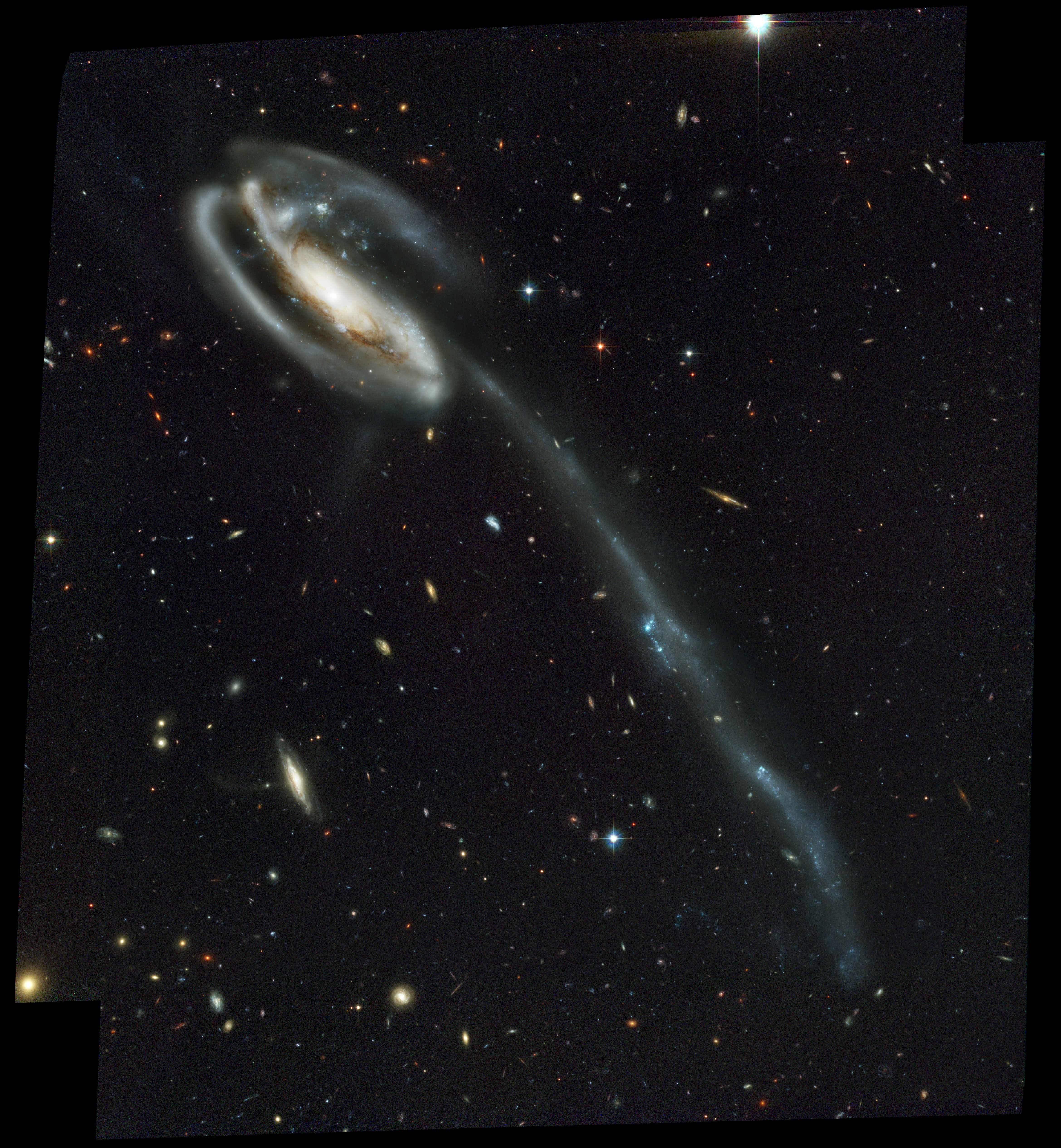Tidal Tail on:
[Wikipedia]
[Google]
[Amazon]
 A tidal tail is a thin, elongated region of
A tidal tail is a thin, elongated region of
Galaxy with an ejected supermassive black hole.jpg, Arc-shaped tidal tails in galaxy 3C186.
 A tidal tail is a thin, elongated region of
A tidal tail is a thin, elongated region of star
A star is a luminous spheroid of plasma (physics), plasma held together by Self-gravitation, self-gravity. The List of nearest stars and brown dwarfs, nearest star to Earth is the Sun. Many other stars are visible to the naked eye at night sk ...
s and interstellar gas that extends into space from a galaxy
A galaxy is a Physical system, system of stars, stellar remnants, interstellar medium, interstellar gas, cosmic dust, dust, and dark matter bound together by gravity. The word is derived from the Ancient Greek, Greek ' (), literally 'milky', ...
. Tidal tails occur as a result of galactic tide
A galactic tide is a tidal force experienced by objects subject to the gravitational field of a galaxy such as the Milky Way. Particular areas of interest concerning galactic tides include galactic collisions, the disruption of dwarf or satellit ...
forces between interacting galaxies
Interacting galaxies (''colliding galaxies'') are galaxies whose gravitational fields result in a disturbance of one another. Major mergers occur between galaxies with similar amounts of mass, whereas minor mergers involve galaxies with masses ...
. Examples of galaxies with tidal tails include the Tadpole Galaxy and the Mice Galaxies. Tidal forces can eject a significant amount of a galaxy's gas into the tail; within the Antennae Galaxies
The Antennae Galaxies (also known as NGC 4038/NGC 4039 or Caldwell 60/Caldwell 61) are a pair of interacting galaxies in the constellation Corvus. They are currently going through a starburst phase, in which the collision of clouds of gas and d ...
, for example, nearly half of the observed gaseous matter is found within the tail structures. Within those galaxies which have tidal tails, approximately 10% of the galaxy's stellar formation takes place in the tail. Overall, roughly 1% of all stellar formation in the known universe occurs within tidal tails.
Some interacting galaxy pairs have two distinct tails, as is the case for the Antennae Galaxies, while other systems have only one tail. Most tidal tails are slightly curved due to the rotation of the host galaxies. Those that are straight may actually be curved but still appear to be straight if they are being viewed edge-on.
History
The phenomena now referred to as tidal tails were first studied extensively byFritz Zwicky
Fritz Zwicky (; ; February 14, 1898 – February 8, 1974) was a Swiss astronomer. He worked most of his life at the California Institute of Technology in the United States of America, where he made many important contributions in theoretical an ...
in 1953. Several astrophysicists expressed their doubts that these extensions could occur solely as the result of tidal forces, including Zwicky himself, who described his own views as "unorthodox". Boris Vorontsov-Velyaminov
Boris Aleksandrovich Vorontsov-Velyaminov (; February 14, 1904 – January 27, 1994) was a Russian astrophysicist. His name is sometimes given as Vorontsov-Vel'yaminov.
He independently discovered the absorption of light by interstellar dus ...
argued that the tails were too thin and too long (sometimes as large as 100,000 parsec
The parsec (symbol: pc) is a unit of length used to measure the large distances to astronomical objects outside the Solar System, approximately equal to or (AU), i.e. . The parsec unit is obtained by the use of parallax and trigonometry, and ...
s) to have been produced by gravity alone, as gravity should instead produce broad distortions. However, in 1972, renowned astronomer Alar Toomre proved that it was indeed tidal forces that were responsible for the tails.
Tidal tails of clusters
Tidal tails have been observed in clusters as well as galaxies. There have been tidal tails identified around NGC 5466. These tails appear to be roughly 4 degrees in the sky, or 1 kpc in length. There have been other clusters observed with tidal tails as well, * NGC 2516, from tip of leading tail to tip of trailing tail, 380 pc. * Theia 456 (COIN-Gaia 13), tidal tail spans 200 pc. * NGC 752, estimates are less than 1.5 kpc to several kpc. *ASCC 101, trailing tail is 100 pc, leading tail is hard to measure due to its position. *Alessi 3, leading tail 120 pc, trailing tail 60 pc *Blanco 1, both tails extend approximately 50-60 pc *Collinder 350, both tails extend approximately 50pc *Melotte 111, both tails span 50 pc *Melotte 25, leading tail is 70 pc, trailing tail is 70 pc *Roslund 6, both tails extend approzimately 100 pc *Theia 517, leading tail is 120 pc and trailing tail is 150 pc. These tidal tails are difficult to measure and different studies show different results. We can most accurately measure tidal tails close to Earth and in the correct orientation.Gallery
Notes
{{reflist *